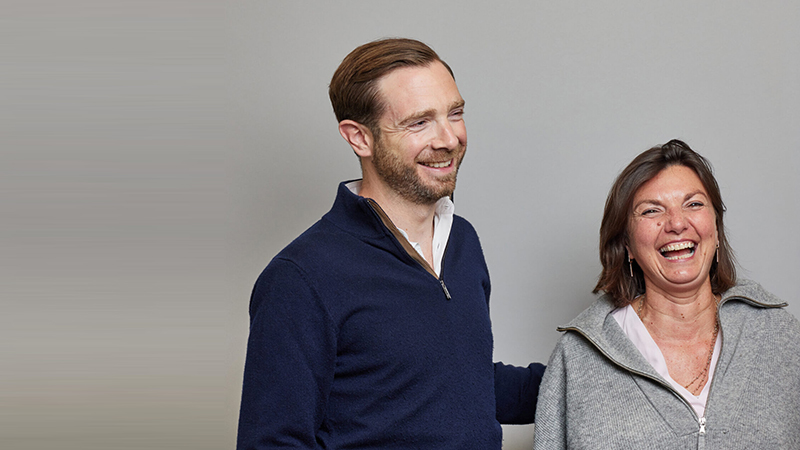Cadro co-founder Nataŝa Williams saw an issue in her industry: “For some of the smartest, or luckiest, people in the world, we produce the most boring spreadsheets.”
Her clients, she explained, are owners of Ferraris, designer handbags, and beautiful homes. But she felt when it came to managing their investments, an equal level of luxury and ease wasn’t available.
Williams and co-founder Jordan Buck previously worked together at LGT Wealth Management for six years, with Williams as partner and head of private management and Buck as partner and head of private equity.
During this period, the duo watched the financial industry start to evolve with technology, creating an accessible experience for clients. But while much of the investing world was leaning into the digital space, Buck said that the “white glove service” of wealth management was still done through phone calls and paper.
See also: Testing the water: Engagement is evolving
“We’ve seen lots of innovation in the sort of mass affluent space. Great robo advisors and trading apps and saving apps and neobanks, but the wealth managers have seen luxury as still being able to chat with someone on the phone and still being sent bits of paper,” Buck said.
“However, I think times are changing, and even wealthy people are more digitally native. They’re used to consuming things as and when it suits them, whether it be five minutes in between tube trains, or whether it be when they’re on a sofa at night at 10pm. I think the industry perhaps failed to spot that.”
The melding of a luxury product with the convenience of modern technology is what led Williams and Buck to create Cadro. While still providing traditional services such as creating portfolios for clients and offering in-person connection, the team has also developed an app that is focused around accessibility. When users log on, they are met with a page that includes each of their investment portfolios. After clicking on the portfolio, clients see a spatial representation of the portfolio’s distribution across bonds, equities, and alternatives.
The layout is based on a psychological study Cadro took to see how people best process information. They found that visual and spatial representations were the majority of people’s key to understanding. Other features of the app include a separate page where clients can upload additional assets such as property and art, which Buck said can help give a more full picture of a client’s financial situation, other than just the money they are looking to invest.
“It’s funny how the wealthier someone gets, the more sophisticated the industry thinks they are. ‘Wow, they’re over £100m now, so we can start discussing structured products or hedge funds or whatever,’” Buck said.
“But you know, ultimately, someone with £1,000 might understand investing much more than someone with £100m. If [a wealth management client] made their money out of making widgets, it definitely does not mean that they have a better understanding of how to create a diversified portfolio.”
Cadro has aimed to add another level of accessibility to investing through creating a learning element. Clients are given access to short videos explaining investment topics that are relevant to their portfolio, or, if there are smaller changes, sent a short written briefing. Peter Cary, head of content at Cadro, said it allows for a more digestible understanding of the industry without jargon or a bombardment of information.
“If you use what we have referred to as the David Attenborough approach to things, where you take some quite complex subjects, but you try to impart it in a way that that brings people along with you, that makes it feel as if you’re on the same team, then people trust you more. They get better understanding, and they start to take much more active interest in looking at their portfolio and doing what we hope to do here, which is actually engage people in their investment experience.”
Cary said even for those clients who were familiar with the world of investing, there is rarely critique that something is too easy to understand. Williams added that for many clients, education can lead to a shift in investing style as they grow more comfortable with the industry.
“It makes people more confident. I think a lot of people hold back and potentially go very low risk when there’s no need. They won’t need that money, they’ve got plenty of income and other things, but they’re terrified because they’ve never done it,” Williams said.
“They didn’t understand it. But once they get the weekly updates, and they can see how it’s going, the confidence grows to ask questions, to understand, to engage, and ultimately to say, ‘Actually, I think my risk level is very low. I know what’s going on. I don’t think this is as scary as I thought it was going to be.”
Cadro gained FCA authorisation in November 2022, and in April 2023, Literacy Capital bought a minority stake in the company. The team is still working to expand its business, now in discussion with advisers in hopes of working in partnership to speak with clients, allowing them access to the app to create an online platform for contribution.
In addition to its internal investment team, Cadro holds an external investment committee meeting each month, with members including Scottish Widows chair Gayle Schumacher and Jonathon Marriott.
Williams added: “It’s like those restaurants where you can see into the kitchen.”










